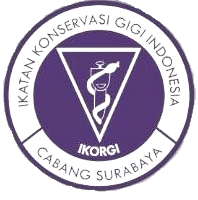Antibiofilm activity of probiotic bacteria Lactobacillus plantarum FNCC 0020 against Streptococcus mutans serotype c
Downloads
Background: Streptococcus mutans (S. mutans) is a Gram-positive bacterium that plays a role in dental caries. Plaque and biofilm formation can be chemically cleaned using mouthwash, such as chlorhexidine gluconates (CHX) 0.2%, which is the gold standard. Another alternative can be developed to inhibit S. mutans biofilm formation by using Lactobacillus plantarum probiotic, which has antibiofilm potency by producing antimicrobial substances. Purpose: This study tested the biofilm inhibition to determine the Inhibitory Concentration that can inhibit 50% of biofilm formation. Methods: This research was conducted as an in vitro experimental laboratory study. Biofilm inhibition testing was performed by using the microdilution method on biofilms formed in 96 well microplates with 0,1% crystal violet staining. Lactobacillus plantarum FNCC 0020 was diluted to several concentrations: 12.5%, 25%, and 50% against Streptococcus mutans biofilm induced by 3% sucrose. The test results in optical density were read using a spectrophotometry with a wavelength of 650 nm. were determined using the GraphPad Prism sigmoidal dose-response method. Results: There is antibiofilm activity of Lactobacillus plantarum FNCC 0020 against Streptococcus mutans, and the inhibitory effect against Streptococcus mutans biofilm showed of 42.43%. Conclusion: Lactobacillus plantarum FNCC 0020 at 50% has biofilm inhibitory activity compared to other concentrations but is less effective than 0.2% CHX.
Al-Ansari MM, Al-Dahmash ND, Ranjitsingh AJ. Synthesis of silver nanoparticles using gum Arabic: Evaluation of its inhibitory action on Streptococcus mutans causing dental caries and endocarditis. J Infect Pub Health. 2021;14(3):324-30.
Kementerian Kesehatan RI. Laporan Riskesdas 2018. Laporan Nasional Riskesdas 2018; 53(9):154–65.
Prasetyo EP, Widjiastuti I, Sampoerno G, Juniarti DE, Wijanarko CI, Kharisna D, Syahria HD, Nabila RA, Suardita K. Sugary drink consumption and tooth decay relationship in diabetes mellitus patients. Conserv Dent J. 2024; 14(2):52-5.
Bedoya‐Correa CM, Rincón‐Rodríguez RJ, Parada‐Sanchez MT. Acidogenic and aciduric properties of Streptococcus mutans serotype c according to its genomic variability. Eur J Oral Sci. 2021; 129(6): e12824.
Wang Y, Shen X, Ma S, Guo Q, Zhang W, Cheng L, Ding L, Xu Z, Jianga J, Gao L. Oral biofilm elimination by combining iron-based nanozymes and hydrogen peroxide-producing bacteria. Biomater Sci. 2020; 8(9): 2447–58.
Ito Y, Ito T, Yamashiro K, Mineshiba F, Hirai K, Omori K, Yamamoto T, Takashiba S. Efek antimikroba dan antibiofilm asam abietat terhadap kariogenik Streptococcus mutans. J Odontologi. 2020;108(1):57–65.
Chen X, Daliri EB, Kim N, Kim JR, Yoo D, Oh DH. Microbial etiology and prevention of dental caries: exploiting natural products to inhibit cariogenic biofilms. Pathogens. 2020; 9(7): 569.
Karygianni L, Ren Z, Koo H, Thurnheer T. Biofilm matrixome: extracellular components in structured microbial communities. Trends Microbiol. 2020; 28(8): 668-81.
Das PK, Samal S. Microbial biofilms: pathogenicity and treatment strategies. PharmaTutor. 2018;6(1): 16-22.
Supranoto SC, Slot DE, Addy M, Van der Weijden GA. The effect of chlorhexidine dentifrice or gel versus chlorhexidine mouthwash on plaque, gingivitis, bleeding and tooth discoloration: a systematic review. Int J Dent Hygiene. 2015; 13(2): 83-92.
Ahirwar SS, Gupta MK, Snehi SK. Dental caries and lactobacillus: role and ecology in the oral cavity. Int J Pharm Sci Res. 2019; 11: 13040.
Barzegari A, Kheyrolahzadeh K, Hosseiniyan KSM, Sharifi S, Memar MY, Zununi VS. The battle of probiotics and their derivatives against biofilms. Infect Drug Resist. 2020; 13: 659-72.
Lestari LA, Helmyati S. Peran probiotik di bidang gizi dan kesehatan. Yogyakarta: Gajah Mada University Press, 2018; 70-3.
Lim SM, Lee NK, Paik HD. Antibacterial and anticavity activity of probiotic Lactobacillus plantarum 200661 isolated from fermented foods against Streptococcus mutans. LWT. 2020; 118: 108840.
Behera SS, Ray RC. Nutritional and potential health benefits of konjac glucomannan, a promising polysaccharide of elephant foot yam, Amorphophallus konjac K. Koch: A review. Food Rev Int. 2017; 33(1): 22-43.
Jang HJ, Kim JH, Lee NK, Paik HD. Probiotic Lactobacillus plantarum Ln4 showing antimicrobial and antibiofilm effect against streptococcus mutans KCTC 5124 causing dental caries. J Microbiol Biotechnol. 2023; 34(1): 116-22.
Liang J, Zhou Y, Tang G, Wu R, Lin H. Exploration of the main antibiofilm substance of Lactobacillus plantarum ATCC 14917 and its effect against Streptococcus mutans. Int J Mol Sci. 2023; 24(3): 1986.
Oja T, San Martin Galindo P, Taguchi T, Manner S, Vuorela PM, Ichinose K, Metsä-Ketelä M, Fallarero A. Effective Antibiofilm Polyketides against Staphylococcus aureus from the Pyranonaphthoquinone Biosynthetic Pathways of Streptomyces Species. Antimicrob Agents Chemother: 2014; 59: 6046-52
Rahmadi A. Bakteri asam laktat dan Mandai cempedak. Mulawan Univesity Press. 2019; 1: 150-200.
Suryani H, Marya DT, Sinaga DM, Usman NA. Uji Daya Simpan Inokulum dan Ketahanan Lactobacillus plantarum terhadap pH Rendah sebagai Agensia Direct Fed Microbials untuk Ternak Ruminansia. Jurnal Peternakan Terapan. 2023; 5(2): 82-7.
Tarawan VM, Anissa A, Sutedja E, Lesmana R. Efek Penggunaan Probiotik Topikal Terhadap Ekspresi MMP-13 dan Kolagen III pada Lapisan Dermis Tikus yang Dipapar Sinar Ultraviolet-B. Indonesian J Clin Pharm. 2016; 5(2): 138-48.
Khiralla GM, Mohamed EA, Farag AG, Elhariry H. Antibiofilm effect of Lactobacillus pentosus and Lactobacillus plantarum cell-free supernatants against some bacterial pathogens. J Biotech Res. 2015; 6: 86-95.
Zaura E, Nicu EA, Krom BP. Acquiring and maintaining a normal oral microbiome: current perspective. Front Cell Infect Microbiol. 2014; 4: 85.
Zamani H, Rahbar S, Garakoui SR, Afsah Sahebi A, Jafari H. Antibiofilm potential of Lactobacillus plantarum spp. cell free supernatant (CFS) against multidrug resistant bacterial pathogens. Pharm Biomed Res. 2017; 3(2): 39-44.

This work is licensed under a Creative Commons Attribution 4.0 International License.

CDJ by Unair is licensed under a Creative Commons Attribution 4.0 International License.
1. The journal allows the author to hold the copyright of the article without restrictions.
2. The journal allows the author(s) to retain publishing rights without restrictions










